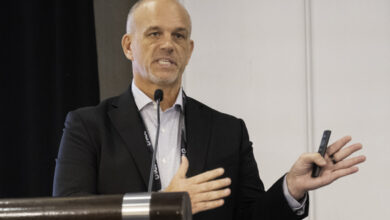Well control faces new complexities with deep, HPHT, horizontal, deepwater, multiwell drilling
By Dan Eby, Cudd Well Control
There have been many advances in the drilling industry in the last 20 years. What was once the exotic has now become routine. Some examples are:
- Deep HPHT wells.
- Horizontal drilling.
- Multiwell pad locations on land.
- Multistage frac jobs.
- Deepwater developments.
These advances benefited the industry in the following ways:
- More reservoirs are commercially viable than ever before.
- They have lightened the footprint of the oilfield on the environment.
- The have reduced the number of wells required to develop reservoirs.
- They have reduced overall development costs.
While these advancements have benefited the industry as a whole, they have also resulted in a number of difficulties when a blowout intervention project is required.
DEEP HPHT WELLS
It is not uncommon to drill wells in excess of 20,000 ft in exploration and development operations. These wells are generally hot and abnormally pressured. This can complicate most blowout intervention projects that may arise. There are several issues that become more difficult on deep HPHT wells.
 Growing trends such as deep HPHT wells, horizontal
Growing trends such as deep HPHT wells, horizontal
drilling and multiwell pad locations on land continue
to push blowout intervention challenges to new levels.
Capping operations can be complicated on these wells. When the blowout involves a fire, the wellhead is usually removed and an emergency wellhead is installed. This can be difficult on wells with normally pressured reservoirs but is much more difficult when the well is flowing at a sonic rate, which is often the case on HPHT wells. The momentum force from the blowout fluids is usually high, which can complicate the wellhead installation and subsequent capping operation. Furthermore, the emergency wellhead is generally considered to be a low-pressure installation. This means that the well will have to be diverted, and a snubbing unit or coiled tubing will be required for the kill operation. This is a lengthy and therefore costly intervention.
Relief well drilling for these wells can be difficult. The narrow margin between frac gradient and pore pressure that makes these wells a challenge is also a challenge for the relief well. This is especially true if the relief well design requires an additional casing string for the intercept. The detection tools used to locate the blowout wells have been successfully used for many years. However, there have been very few relief wells drilled deeper than 16,000 ft. A very deep intercept greater than 20,000 ft will be a challenge to any relief well team. If the deep intercept cannot be made, a shallower depth will need to be chosen. This complicates the kill operation as it will not be made close to the reservoir.
HORIZONTAL DRILLING
Horizontal drilling is used in development situations to increase the reservoir exposure. This increased exposure is desirable for several reasons. The total production from a horizontal well can be significantly greater than a straight or conventional directional well. Moreover, the flow rate from the well, in many cases, is greatly enhanced in horizontal wells. The increased flow rate during production can also be expected if the well blows out. While this doesn’t necessarily complicate a blowout intervention, it can lengthen the job.
Relief well drilling for horizontal wells can also be a challenge. Choosing the correct intercept depth is important. If the intercept depth chosen is the heel of the well near the kickoff point, the kill can be difficult as it is essentially an off-bottom kill. Intercepts in the lateral portion of the well can be difficult, especially if the well has been completed. This is due to the fracture stimulation routinely used in many of these types of wells and the hardware used to perform the stimulation. To date, very few horizontal wells have required relief well intervention for a surface or underground blowout.
Wells with multiple horizontal laterals can also be complicated relief well projects. Relief well intercept points in these wells must be chosen carefully. The intercept point candidate in multilaterals is above the uppermost lateral. This off-bottom kill is even more difficult than in a single lateral well.
MULTIWELL PAD DRILLING
Multiwell pad drilling is gaining in popularity in many places. This is essentially the land version of the offshore platform. When numerous wells are placed close to one another, the chances for collateral damage from a blowout increase significantly. A single well fire may result in several well fires if the pad is in production mode. This has been experienced in numerous offshore blowouts on production platforms throughout the years.
The close proximity of the wells can lead to difficulty in capping operations. It is always desirable to have as much room as possible when capping a blowout. The presence of additional wells and production equipment near a blowout on a pad location limits the approach and space available for the equipment needed for capping operations. Wind is a major consideration and, if the desired approach is limited by other wells on the pad, there is little that can be done other than wait for a wind change.
Simultaneous operations are often used during the drilling and completion phase of the development. Drilling, wireline, coiled tubing, fracturing, flow back, production and snubbing operations can all be under way on the pad in some sort of combination. When these operations are done on a pad site, the amount of equipment to be removed to gain access to the wellbore during a blowout is often increased. In case of a fire, some of this equipment becomes debris.
Additionally, protecting undamaged equipment and wellheads requires considerable effort. If the blowout involves a fire, the wells on the pad have to be protected from the radiant heat generated. If the blowout does not involve a fire, considerable time may be required to secure the remainder of the uninvolved wells.
 On wells where multistage fracturing is used,
On wells where multistage fracturing is used,
blowouts have taken place during the fracturing
operation, oftentimes due to failed casing.
In the case of an underground blowout that broaches around the well and a crater forms, the probability that the adjacent wells will also be lost is greater. This problem has been experienced in numerous situations offshore where the entire production platform is lost due to cratering.
MULTISTAGE FRAC JOBS
The use of multistage frac jobs in conjunction with horizontal drilling is a common completion scheme in shale plays in the US. This stimulation technique requires downhole hardware and surface services to isolate, stimulate and perforate the horizontal section of the well several times. Pumping on the well as a blowout control measure can be complicated due to the hardware installed downhole for the stimulation.
There have been numerous blowouts on these types of wells during the fracturing operation. Most of the jobs are due to failed casing. Casing failures within 30 ft of the surface can usually be controlled. The solution involves extensive excavation and installation of an emergency wellhead. These jobs can be lengthy.
Once a new wellhead is installed, the best option for a kill is to run a kill string to bottom. This is usually done with coiled tubing or snubbing. The probability of success for the kill relies on being able to find and access the bottom of the hole with the kill string.
Deeper casing failures can be much more challenging. If the casing is parted and access to the bottom of the hole is not possible, a relief well is likely required.
DEEPWATER DEVELOPMENTS
Deepwater well control operations have numerous complications and difficulties. The problems that have been a challenge for all drilling and production operations can also provide difficulties during well control events. The following problems can greatly complicate well control mitigation operations and may compromise the control effort:
- Narrow pore pressure/frac gradient profiles.
- Hydrates.
- Equipment failures at the sea floor.
- Weather.
- Loop currents.
Most of these difficulties have been overcome through a long and expensive learning curve. However, when some of these problems are experienced during well control operations, they can lead to escalation of the original incident.
Fortunately for the industry, well control problems in deepwater operations have been few. The likely reason for this is that most deepwater prospects are oil exploration and development plays. The likelihood of well control problems increases dramatically when gas is encountered. The downside to this is that there are few individuals in the industry who have experience dealing with well control events in deepwater. This is likely to change when operators start developing gas reservoirs in deepwater.
SUMMARY
The oil industry has made numerous advances in drilling and completion tools and techniques that have greatly enhanced the search for and development of oil and gas reserves. The challenges that these advances present to well control service providers are numerous. In some cases, overcoming these difficulties requires brute force and persistence. In other cases, detailed engineering and finesse are the answer.
Regardless of the solution, the probability of more difficult well control intervention projects in the future is high.





2 Comments